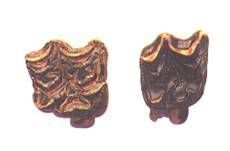Deleted
Deleted Member
Posts: 0
|
Post by Deleted on Aug 21, 2006 16:29:22 GMT
Hi ! Equus neogaeus was a horse that lived in South America until about 7000 years before today, according to this site: www.ele.net/LaBelle/pampas/pampas.htmIt may have arrived from North America during the intercontinental faunal change. |
|
|
|
Post by another specialist on Aug 22, 2006 17:21:24 GMT
i believe its spelt Equus neogaeus
|
|
Deleted
Deleted Member
Posts: 0
|
Post by Deleted on Aug 22, 2006 17:27:57 GMT
Hi ! i believe its spelt Equus neogaeus This is absolutly possible, but I found neogeus more often than neogaeus, so I have no idea.  |
|
Deleted
Deleted Member
Posts: 0
|
Post by Deleted on Aug 22, 2006 17:29:58 GMT
Oh, I see ... Amerhippus neogeus but Equus neogaeus, so neogaeus would be right. I have changed it, Thank You !  |
|
|
|
Post by another specialist on Aug 22, 2006 17:42:56 GMT
My pleasure mate
|
|
|
|
Post by RSN on Sept 7, 2006 21:38:10 GMT
Amerhippus is it subgenus, like Hippotigris is the subgenus of mountain zebra, Equus (Hippotigris) zebra.
|
|
|
|
Post by another specialist on Sept 8, 2006 9:48:09 GMT
thank you Rsn for the explaination
|
|
|
|
Post by RSN on Nov 2, 2006 22:29:36 GMT
Info from my book project:
Equus neogeus†
Nome oficial em português
Nomes vulgares
Gênero e espécie Equus (Amerhippus) neogeus
Autor/Data Lund, 1840
Citação
Local tipo
Holotipo
Sinônimos Equus neogeus Lund, 1840
Amerhippus neogeus
Equus vandonii
Subespécies Monotípico.
Características Cerca de 400 kg. A maior e mais graciosa espécie de cavalos sul-americanos.
Biologia Seus predadores seriam os tigres-dente-de-sabre e lobos, mas também foram encontrados restos fósseis em sítios culturais, caçados e consumidos por antigos humanos moradores da região.
Dieta Gramíneas.
Habitat Pampas.
Distribuição geográfica Fósseis encontrados no Brasil e na Argentina.
Distribuição histórica Pleistoceno Superior.
Estado de conservação Extinto.
Observações Considerado sinônimo de E. rectidens por alguns autores. Estratigraficamente restrito ao Lujanense na Argentina.
|
|
|
|
Post by RSN on Nov 2, 2006 22:37:50 GMT
Image from the skull:  |
|
|
|
Post by another specialist on Nov 3, 2006 7:50:40 GMT
Thanks RSN for informing me of the above error uploaded wrong pic up.
|
|
|
|
Post by another specialist on Nov 3, 2006 7:55:34 GMT
 Here is the other pic from same pic |
|
|
|
Post by RSN on Nov 5, 2006 20:15:24 GMT
Thanks RSN for informing me of the above error uploaded wrong pic up. No problem!  |
|
|
|
Post by another specialist on Nov 5, 2006 20:25:30 GMT
thanks mate  |
|
|
|
Post by Carlos on Feb 8, 2007 17:20:38 GMT
www.grupopaleo.com.ar/museodemiramar/naturales/naturales15.htmThe note in the above site, gives reference of the findings in 1995 in the archaeological site by Las Brusquitas River, close to the city of Miramar (Argentina) in the Pampas near Buenos Aires. The site has been interpreted as camp of hunters and the material recovered in it is a mixture of mostly marine and land mammal remains of entropic origin (some of them with evidence of hunting and butchering) and cultural artefacts. A few species are still present in the area, some are regionally extinct and a few are extinct species. The stratigraphy and the presence of human artefacts have permitted an accurate date of about 3000 y BP. Among the mammal remains are those of Equus (Amerhippus), an extinct horse.
|
|
|
|
Post by another specialist on Feb 8, 2007 22:12:30 GMT
|
|
|
|
Post by RSN on Apr 14, 2007 23:27:23 GMT
Did the neogaeus name mean ''New World'', in reference to the American continent?
|
|
|
|
Post by Carlos on Apr 15, 2007 10:57:11 GMT
I think so, Rafael:
Neo: greek for NEW
Gaeus is the masculine accordance for Gæa or Gea, the latin name of the Greek Goddess Earth.
So the name of this species (Equus neogaeus) is kind of grammatical nonsense, but the meaning is obvious: THE HORSE FROM THE NEW WORLD
|
|
|
|
Post by RSN on Apr 15, 2007 23:13:08 GMT
Maybe it was named before the knowledge that horses firts evolved in North America.
|
|
|
|
Post by another specialist on Apr 17, 2007 13:10:55 GMT
Equus vandonii new species of fossil horse from corumba mato grosso do sul brazil De-Souza-Cunha, F. L. 1981 Boletim do Museu Nacional de Rio de Janeiro Geologia (40): 1-19 The 2nd fossil species of the subgenus Amerhippus from Brazil and the 7th spp. discovered in South American is described. This horse collected at Pantanal Mato-Grossense is suggested to be an intermediate species between E. (A.) curvidens [Soua Cunha] and E. (A.) neogeaus (J. Bosa)because of some characteristics of the skull and dentition especially the M1 [molar]. [The new species probably is from the Upper Pleistocene]. Equus vandonii is now classed as the same as Equus (Amerhippus) neogaeus trophort.com/005/380/005380242.html |
|
|
|
Post by RSN on May 6, 2007 0:52:56 GMT
Maybe it could have been a subspecies, since we have no knowledge about prehistoric creatures coloration (in 99% of cases).
|
|